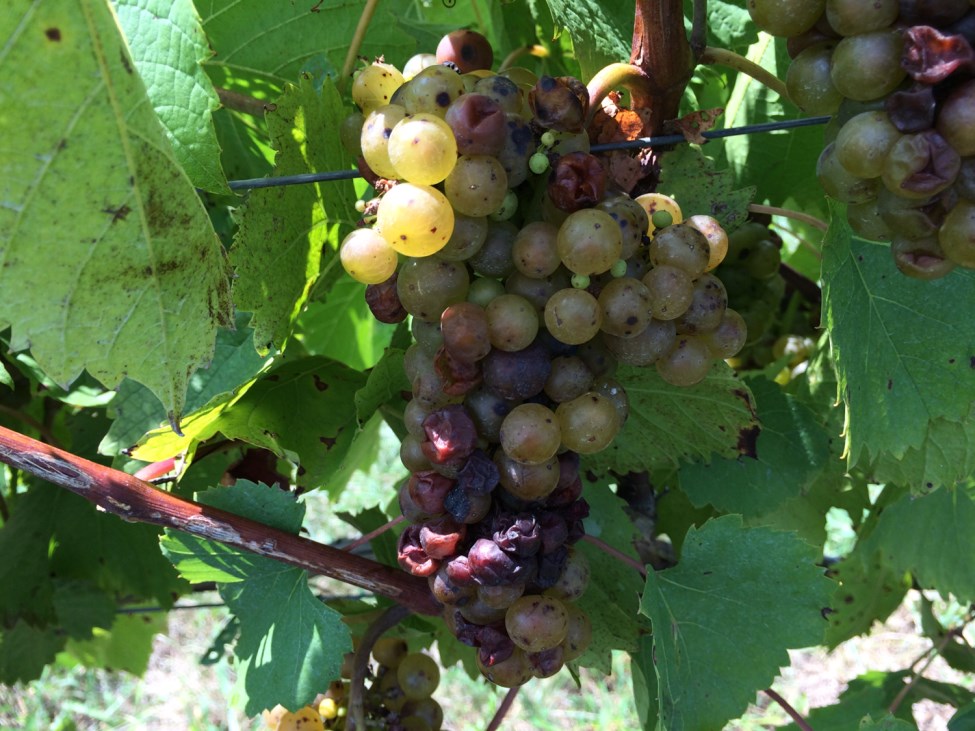Vinews
No. 8 — July 18, 2022
Contents:
Sour Rot Managment

Recent research out of Cornell by Greg Loeb and Katie Gold over the past couple of growing seasons has shed some light on reducing the incidence of sour rot. In the past the common management of sour rot has been to start applying Oxi-date and an insecticide on a weekly schedule once sour rot symptoms appear. This has resulted in selecting fruit flies Drosophila melanogster with resistance to at least three different classes of insecti-cides. Fruit flies in New York as well as Missouri have developed resistance to three different chemical classes of insecticides (Table 1). The resistant fruit fly populations remain susceptible to Delegate. (spinetoram)
Table 1. Drosophila melanogaster has developed resistance to three different chemical classes in vineyards in New York and Missouri.
| Trade name | Common name | Sub-group or active ingredient | IRAC |
|---|---|---|---|
| Assail | acetamiprid | Neonicotinoids | 4A |
| Malathion | malathion | Organophosphates | 1B |
| Mustang Maxx | Zeta-cypermethrin | Pyrethroid/Pyrethrins | 3A |
Research out of Cornell suggests the following:
- Start monitoring your vineyards for sour rot once the grapes attain 12 brix
- Once berries attain 15 brix and wet rainy conditions persist coupled with warm temperatures this should be a red flag that sour rot is likely.
- Warm evening temperatures between 68-77° F coupled with rainy conditions when berries attain 15 brix should also be cause for alarm
- Sour rot initiates on wounded berries in which the berry skin has been damaged. Although some evidence suggests that berry wounding occurs in tight clustered cultivars such as Vignoles simply due to the cluster architecture. There are other entries for sour rot such as hail damaged berries, grape berry moth larvae, or mechanical damage to berries from mechanized leaf thinning, canopy management etc.
- The application of Oxidate plus an insecticide staring at 15 brix followed by a second application prior to harvest is as effective in controlling sour rot as compared to four applications.
- Starting a sour rot management program after symptoms appear is not as effective as starting a pre-emptive sour rot management program prior to sour rot symptom development.
- The two spray program worked effectively during a low incidence year (dry season) and a high incidence year (wet season) as compared to a four application spray program.
Take home: Monitoring the fruit brix, being aware of the weather conditions and timing the spray application, and are key to sour rot management. Being pre-emptive can help reduce sour rot and save you dollars on pesticide applications.
topHigh Temperatures and Phytotoxicity
- Common fungicides such as copper products, sulfur products, and captan can cause phytotoxicity, but seldom will they cause phytotoxicity by themselves
- Oils, adjuvants, stickers can enhance penetration of the pesticide through the cuticle. Urea applied as a foliar spray enhances pesticide penetration
- High humidity conditions slow pesticide dry time and may enhance penetration
- Temperatures over 90° F and sulfur applications can result in phytotoxicity especially at high relative humidity that decrease drying time
- Captan can become phytotoxic at high temperatures. Avoid spraying when temperatures are above 85° F
- Adjuvants can heat up the spray mixture — be especially careful with your spray cocktail during high temperatures
Please scout your vineyards on a regularly scheduled basis in an effort to manage problem pests. This report contains information on scouting reports from specific locations and may not reflect pest problems in your vineyard. If you would like more information on IPM in grapes, please contact Dean Volenberg at 573-882-0476 or 573-473-0374 (mobile) or volenbergd@missouri.edu